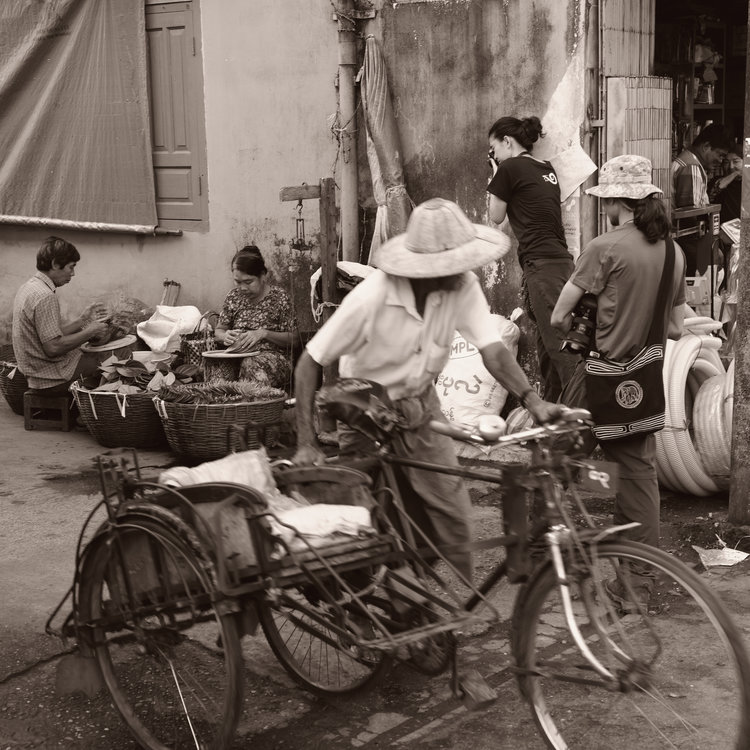One of the best ways to learn any skill is by observing master practitioners at work.
That was the reasoning behind offering such this intimate workshop experience; to ensure that participants had the invaluable opportunity to observe Daniel Schwartz and Philip Blenkinsop, seasoned exponents of their art, at work in the field.
The ability to pre-empt images and to frame, focus and shoot while moving is an art best demonstrated in such an environment.
Importantly, Daniel and Philip are generous and non-possessive when it comes to the events unfolding around them; they encouraged participants to go forward and engage with people, camera in hand, while offering constructive advice in real time.
The seven days were spent observing, building confidence, and seeking out those special moments that as photographers we live for, documenting them as they happen, whether walking the streets, journeying by train, bus or boat or simply sat at a tea shop watching the world go by.
It is these captured frames that, when pieced together to form a whole, make each person’s road journal a unique commentary on a memorable journey.
After travelling through Bago, Kyaktiyo, Hpa An and Moulmein, the workshop culminated in an exhibition and presentation of the maquettes of the journal in Rangoon with many attendees from the local community.
Please view the masterful webpage that Philip put together to tell the story of this adventure and collaborative learning experience among 5 enthusiastic students and 2 dedicated instructors.
A selection of the work and testimonials of the 3 grant recipients of the workshop are exhibited below.
Rita Khin
Rita Khin is a documentary photographer from Yangon, Myanmar and is a member of Thuma Collective, which started in 2017 and includes five women photographers from Myanmar who are dedicated to visual storytelling.
Rita’s work primarily covers gender diversity, women’s issues and LGBT related stories. She mostly covers stories on her own terms and often works for international organizations. She began her photography career by attending a documentary photography workshop organized by Yangon Photo Festival. Since then, she has been cultivating her photography work extensively. She is now based in Yangon. www.ritakhin.com/home
“I decided to apply for this workshop because I want to push the limit I am facing with photography and do more of the things I thought that I can’t. I believe this workshop was the one thing I needed to unlearn and relearn my perspectives about photography. It turned out to be better than I expected. Those 7 days with the best mentors, Philip and Daniel, were the best experiences and [created] insightful moments for me.” – Rita Khin
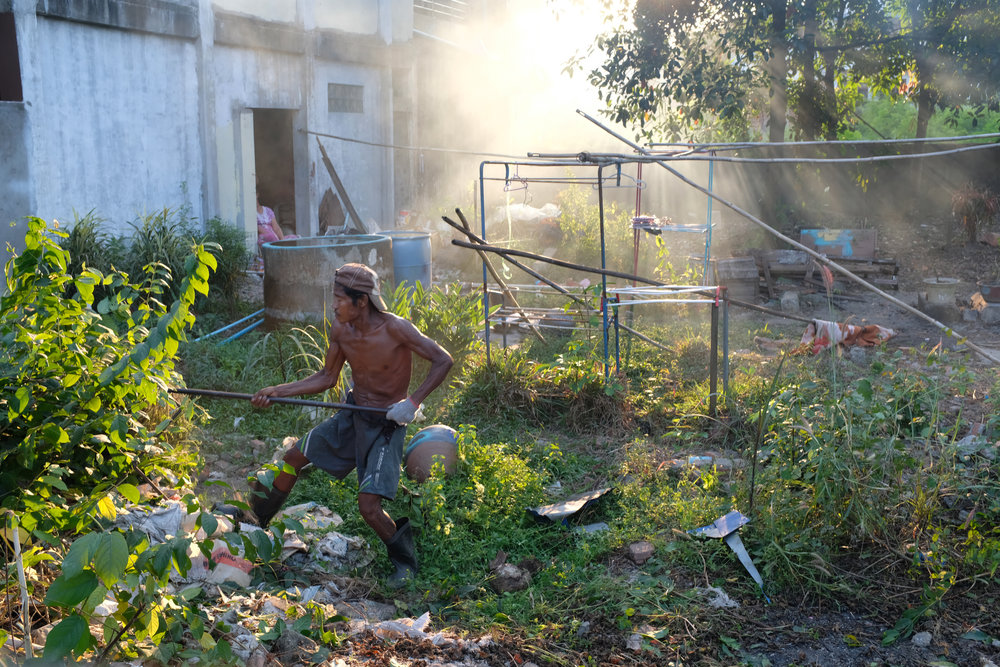 Photo by Rita Khin
Photo by Rita Khin
“The trip begun with excitement and uncertainty. I have never been on this sort of voyage alongside with mentors to teach me on the spot. This trip was much more thrilling with new things to learn which are even better than I had imagined. I was taught with new perspective on photography, to see things and always be prepared and ready with my camera.
Evening dinner time with alive conversation are the time to reflect about our day and learn from experiences. Philip and Daniel’s life stories and experiences are one of the best I love about this workshop because that creates more intimate and personal closeness with both of you rather than mentor/mentees relationship.
Now I know what it feels like to wander around by myself with a bottle of water and my camera. It’s not to learn about street photography/landscape photography or any types of photography. It’s beyond the types and labels. It’s about purely loving photography and being there with your camera. I love this workshop because I felt it brings me much closer to photography and to understand more why photography is with me and me with it. I crave more for this. I now keep wondering around with camera wherever I go. I start shooting tons of photos as I walk along. (But of course, not in a meaningless way of pressing the shutter constantly and not knowing what you are doing there.)
 PB pushing Rita out of her comfort zone in Moulmein. © Daniel Schwartz / VII Photo
PB pushing Rita out of her comfort zone in Moulmein. © Daniel Schwartz / VII Photo
Besides, I also learnt to edit, sequencing the images and things to keep in mind in advance for photo book. This 7 days of voyage is the most insightful and amazing turn-up in my photography career. I am truly grateful and thankful for both Daniel and Philip’s advice for me to improve in my approaches to get good images.” -Rita Khin
 Rita Khin introducing her work to the gathered audience for the “Burmese Days” exhibition on the final night in Rangoon. © Philip Blenkinsop / VII Photo
Rita Khin introducing her work to the gathered audience for the “Burmese Days” exhibition on the final night in Rangoon. © Philip Blenkinsop / VII Photo
Ko Myo
Min Myo Nyan Win is a freelance documentary photographer, also known as Ko Myo in photography circles. He is from Burma and has been photographing a story about the wild elephants that are smuggled in the country since 2014. www.komyophoto.com
“In early November, I saw about the Burmese day workshop on social media, so I went and read in detail about the workshop on the VII Photo Agency website. I found that they have the scholar program for the workshop. After I enquired, I knew I couldn’t afford it because I need to pay $500 and travel charges even if I received the scholarship.
Luckily, I got a full scholarship to join the VII workshop and learned about photography, editing photos and making photo books, etc. I have lots of experiences about shooting photos of wild elephants in Myanmar but I am not proficient in shooting photos about people. I had many experiences learning how to take photo of people, and travelling experiences from this workshop. Therefore, VII Photo workshop is a valuable training class for me. I am thankful to VII Photo and my dear Philip and Daniel.” – Ko Myo
 Hpa An. Thanlwin. © Ko Myo
Hpa An. Thanlwin. © Ko Myo
“Ko Myo came to the workshop with the reputation of never having taken an image of a human being in his life. Something of an in-joke among Burmese photography circles. “He can’t do it” his colleagues would affectionately say. Elephants were his sole focus and Daniel and I promised him that we would not find any elephants on the trip. Stepping up to the plate, he nailed some wonderful images and set about proving all his critics wrong.” – Philip Blenkinsop
 Ko Myo introducing his work to the gathered audience for the “Burmese Days” exhibition on the final night in Rangoon. ©Philip Blenkinsop / VII Photo
Ko Myo introducing his work to the gathered audience for the “Burmese Days” exhibition on the final night in Rangoon. ©Philip Blenkinsop / VII Photo
Tawatchai Pattanaporn
Tawatchai is 37 years old, and was born and grew up in Bangkok, Thailand. His interest in photography started after graduating from the architecture department when he was 22 years old. Now, he runs an analog photography lab in Bangkok, named “Patani Studio.”
“I’ve been following Philip Blenkinsop’s work since I began to take photo about 15 years ago when he was based in Thailand. All of his published works are wonderful, very honest, and emotional and exhibit different perspective of human being than other photographers. It also inspires me to improve my skill over all these years.
Being part of this workshop which was organized as a road trip helped me realize the kind of magic that his works possess, what he’s looking for, his skill and his method to acquire the photo he wants. Philip worked really hard during the workshop to guarantee the participants would get the best out of it. I truly admire his dedication. He ushered us to push ourselves further. Whenever he had a chance he would give us advice on technique that would fit each of us and we would spend some time practicing together to make sure that we know how to use it. His approach to acquire high standard photo has taught us not to compromise with any lower standard of quality.
Daniel Schwartz believes in what he sees. He might not take any photo all day but he perceives and manage his memory by drawing them out. His way of describing how the brain receives images was very interesting and prudent. His experience always triggered something in our mind. His works, elegant and complete. He puts 2 or 3 photos together and that changes the way we interpret his work, bringing new perspective into editing and sequencing photos.
I’d like to share one special moment: when Daniel and I were walking around and taking photo at Golden Rock, Myanmar, Daniel pointed to what was going on in front of us about 3 metres away. It was two young porters, behind them was an imitation of a mountain. They were both squatting on the first step of stairs. After a while they stood up stretching their arms and torso to different sides. They made fun of each other just as ordinary human beings do. That was a gorgeous photo being revealed right there! It was a magical moment. Daniel told me it would make a great photo. Neither of us got it but it was a great ‘seeing’ experience; a memory so crystal clear that I could draw it.” – Tawatchai Pattanaporn
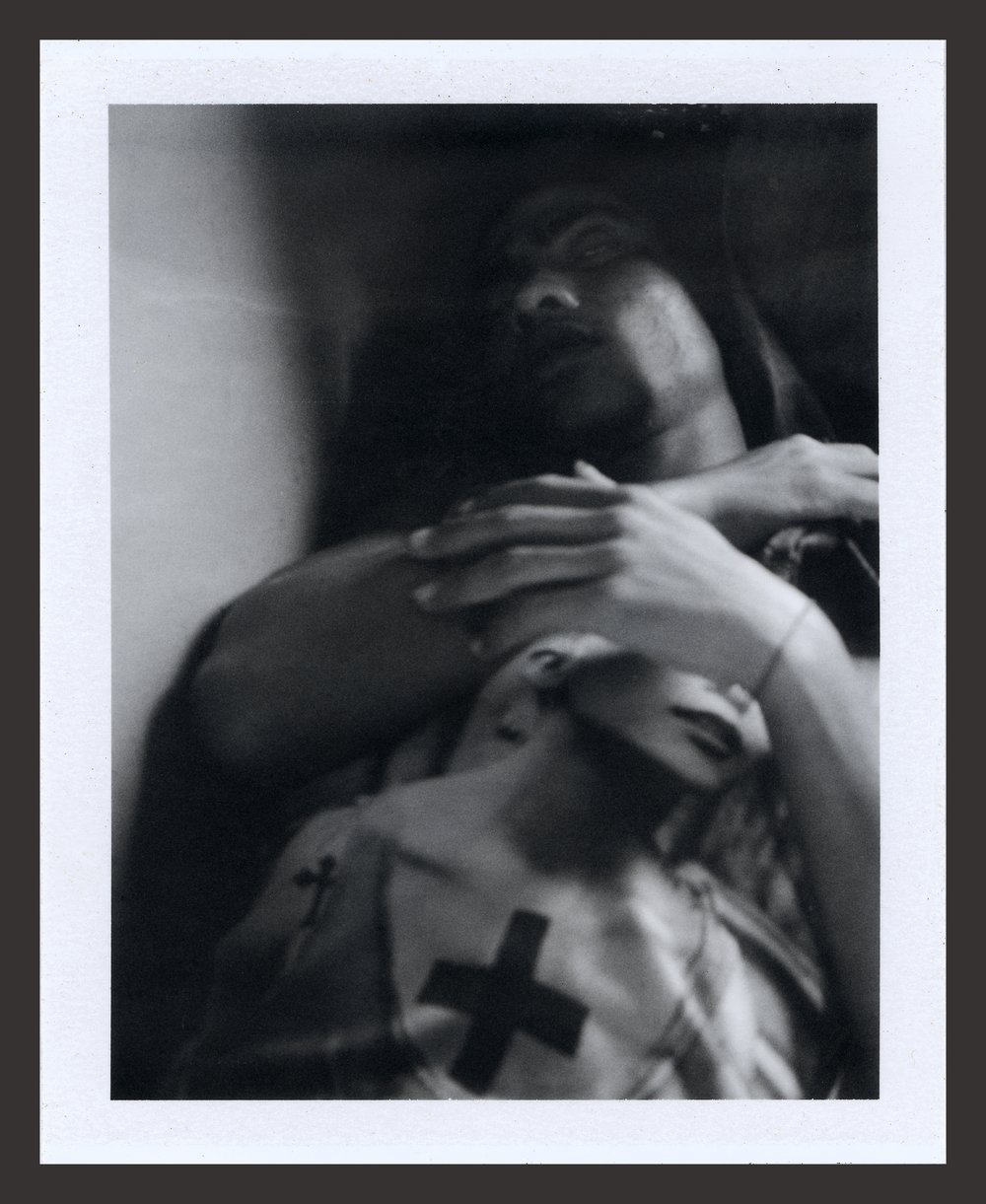 Burma. © Tawatchai Pattanaporn
Burma. © Tawatchai Pattanaporn 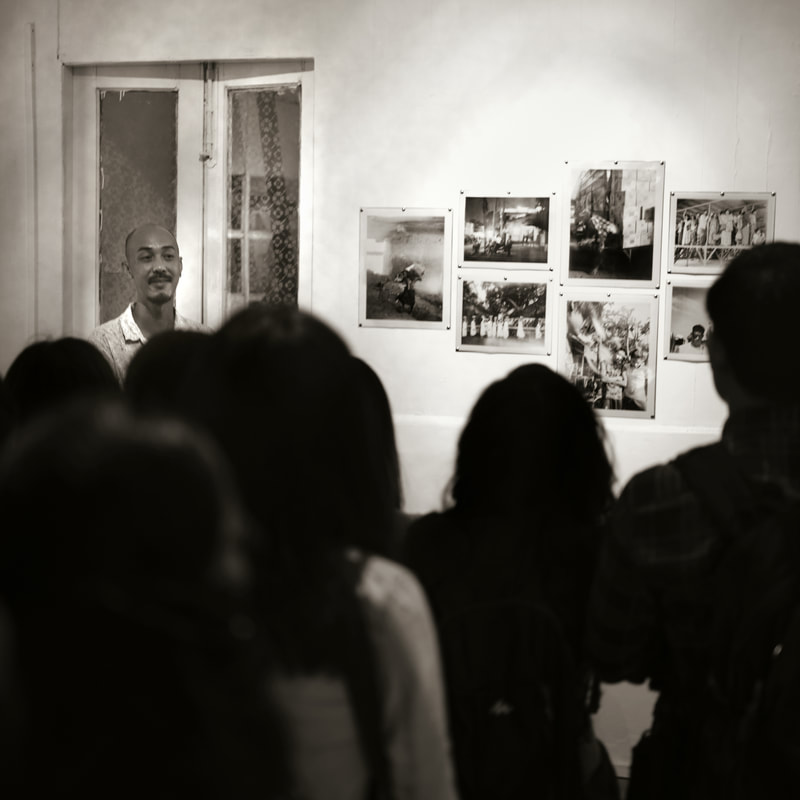 Tawatchai Pattanaporn presenting his work at the final night exhibition in Rangoon. ©Philip Blenkinsop / VII
Tawatchai Pattanaporn presenting his work at the final night exhibition in Rangoon. ©Philip Blenkinsop / VII ![]()
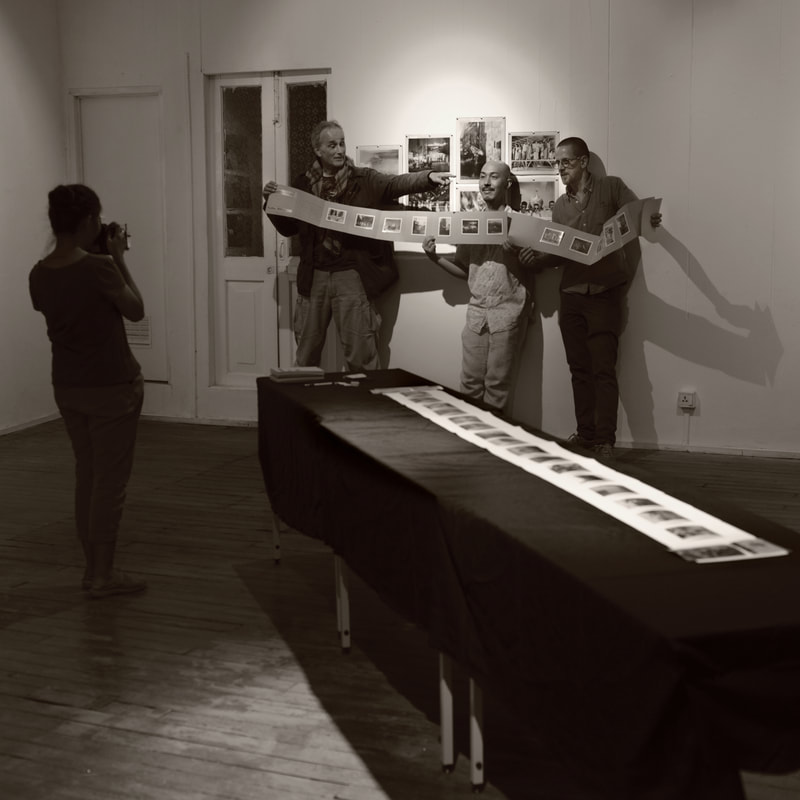 Daniel and Philip with Tawatchai and his handmade book on the evening of the presentation in Rangoon.
Daniel and Philip with Tawatchai and his handmade book on the evening of the presentation in Rangoon.
“Being a photographer in Southeast Asia today, we are very much influenced by the internet. There are so many great photos from around the world that we might be able to snatch their visual form and apply it to our work only very superficially.
Our memories are filled with references that we like. We try to replicate those references and call them progress. In a way, this is a trap but we convince ourselves that we have made decent photos. Hence, the development of photography is heading pretty much the same direction.
We have so many beautiful photos these days but they are all very similar in technique, composition and content. There are so many workshops each year in this region; the mentors are international photographers however the number of participants are overwhelming to the point of becoming obstacles for the development of skill and perspective.
The ‘Burmese Days’ workshop with Philip Blenkinsop and Daniel Schwartz has been my best learning experience.
For 7 days we travelled in a small group, by train and other public transportation to immerse ourselves in ‘life’ and allow ourselves the opportunity to shoot at all times.
We were given freedom (of shooting). All needed to stay focus, a photo could be made at any moment. Cameras in our hands, everything was set ready, streets and fresh markets were our battlefields. A good photo can be created just right in front of us.
Daniel and Philip would point out which were decent photo-possibilities and which were not, guiding us to different photo opportunities in different situations and showing us how to overcome constraints to acquire a decent photo.
They shot from their own perspectives, interpreting scenes and creating amazing pieces, much beyond our expectation even though we were looking at the same thing at the same time.
This workshop impressed upon us the need to rely on our own perspectives to create photos in our own direction so they turn out to be unique, standing out from others.
The daily review session remind us that those photos we think were great could still be better. I believe the most obvious improvement is that when we see the moment in front of us we now know what to do to get decent photo.
I’d like to thank VII Academy for making this workshop happen and also for supporting several local photographers including me. The experience earned from the workshop will continuously propel us into the future and also allow us to pass knowledge on to other local photographers.” –Tawatchai Pattanaporn
Read more about the workshop here.
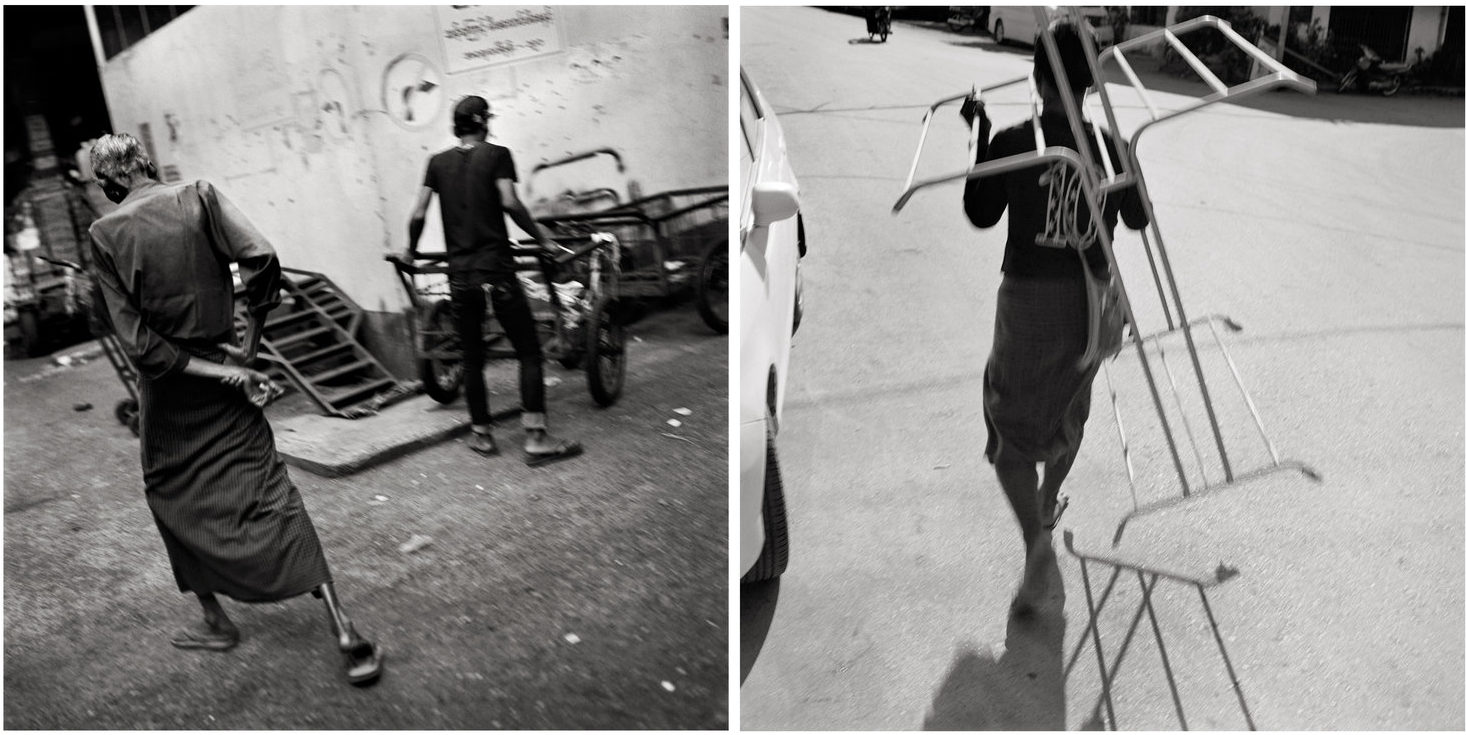 Goings-on in Moulmein (5 December 2018, left) and Hpa an (4 December 2018, right), Burma. ©Daniel Schwartz / VII
Goings-on in Moulmein (5 December 2018, left) and Hpa an (4 December 2018, right), Burma. ©Daniel Schwartz / VII 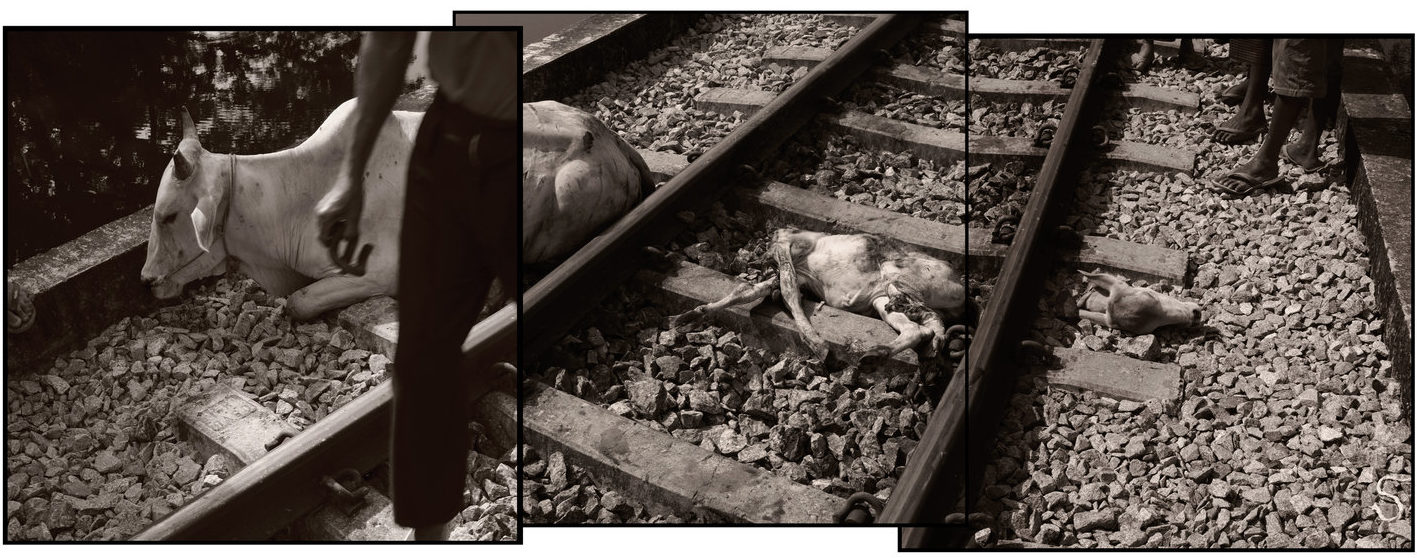 On the Bridge at Kyaung Su our Loco ploughs into three cows and a calf, derailing itself in the process as two of the beasts are tumbled to death under its carriages. What I can only assume is the Mother lies terrified, broken and dying on the tracks next to her decapitated calf. I try to comfort her with soothing words and a calming hand, questioning onlookers whether someone cannot shoot the poor beast, but even with the two full carriages of newly graduated Tatmadaw, it seems there is not a gun to be had, or perhaps it was the will that could not be found, so I leave her suffering and waiting there in the heat. Kyaung Su, Burma, 10th December 2018. ©Philip Blenkinsop / VII
On the Bridge at Kyaung Su our Loco ploughs into three cows and a calf, derailing itself in the process as two of the beasts are tumbled to death under its carriages. What I can only assume is the Mother lies terrified, broken and dying on the tracks next to her decapitated calf. I try to comfort her with soothing words and a calming hand, questioning onlookers whether someone cannot shoot the poor beast, but even with the two full carriages of newly graduated Tatmadaw, it seems there is not a gun to be had, or perhaps it was the will that could not be found, so I leave her suffering and waiting there in the heat. Kyaung Su, Burma, 10th December 2018. ©Philip Blenkinsop / VII
